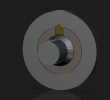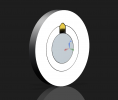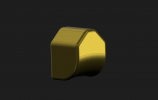ThanksJust saw this. It's a great idea. Got it from the first scribble. Essentially mimicking a keylock with pins. Only tinkering would be how to achieve flawless ball drop when released. Either with a spring or geometrical form in the blade to force them down when unlocked and turned. Three point contact for strength while the stop pin is a safety just in case. Another issue would be securing the button not to engage when working. A small lever would do just fine. When I get some free time I'll CAD it to see possibilities, curiosity sake.
I improvised a little today to try this with two balls , the balls are 3 millimeters Dia. . When I *remove* piston that shim /blade/ push them inside *pivot * I just need to turn it . It will work flawlessly I'm sure . Even with one ball, it locked perfectly without any play .
About the button , it can be a little deeper into the frame . The forces acting on the pivot through the blade and rollers are vertical, they can't *move* piston on side so the rollers can be very close to the transition where the thinner part of *piston* begins ....that mean short movement of button ? If I explained well what I mean


I think that rollers /say 4mm Dia. / need to be IN blade just 1 - 1.5 mm. no need for more . That way blade would push them down when button was pressed .
Tomorrow I will try with four balls, I can easy try that in my shop. If it works properly, I will visit a friend to do it properly on Lathe and mill......................





 But little complicated to do ?
But little complicated to do ?